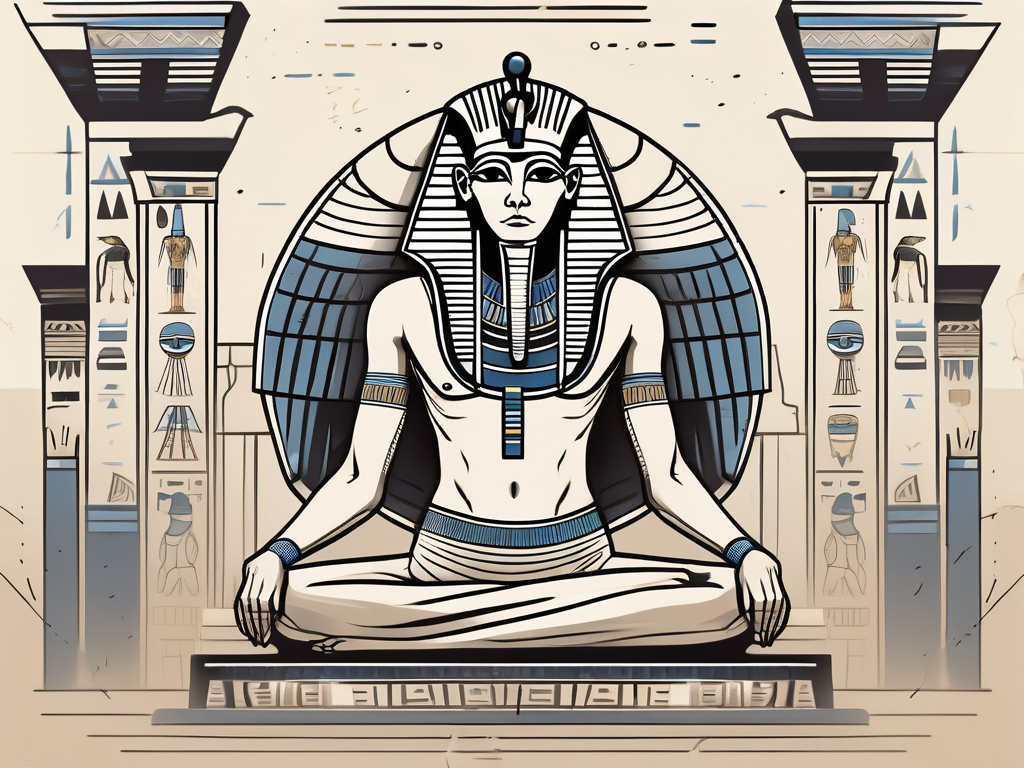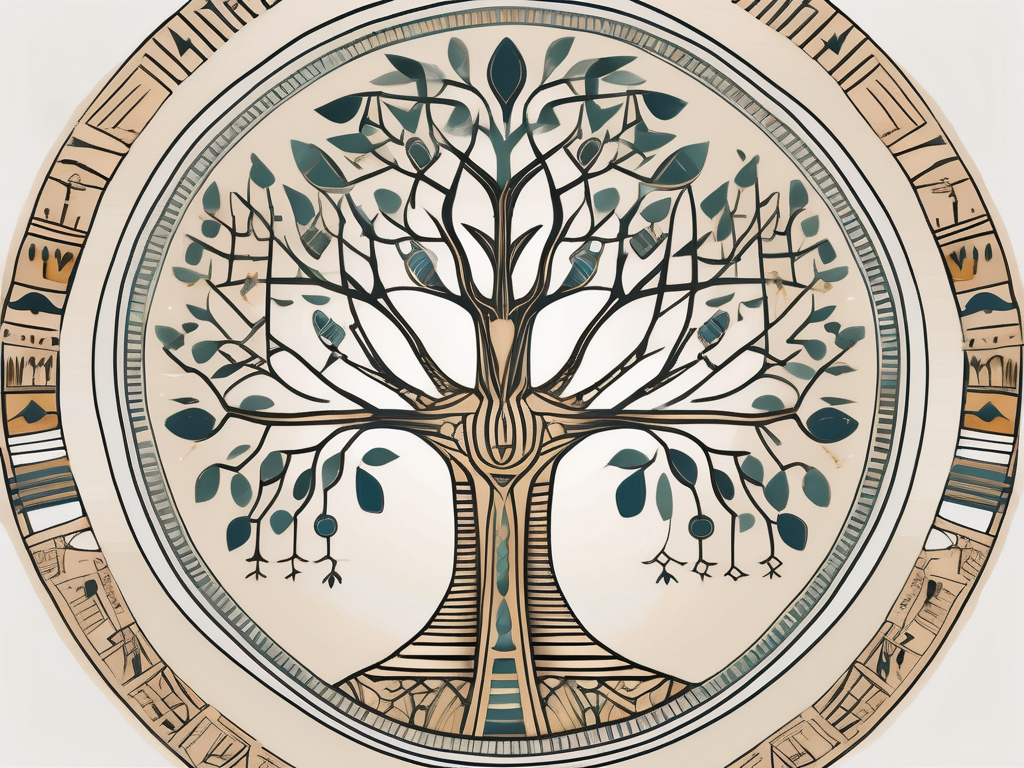The mythology of Ptah-Sokar-Osiris holds a significant place in ancient Egyptian religion and belief systems. This captivating deity, revered by the ancient Egyptians, showcases the interconnectedness and syncretism of their pantheon. Understanding the role, origins, worship, and iconography of Ptah-Sokar-Osiris provides a fascinating journey into the religious and cultural dynamics of ancient Egypt.
Understanding the Egyptian Pantheon
Ancient Egyptian religion consisted of a complex pantheon of gods and goddesses, each embodying different aspects of life, nature, and the afterlife. The gods played a crucial role in the daily lives of the Egyptians, with their presence felt in every aspect of society.
The pantheon was composed of numerous deities, ranging from powerful gods like Ra, the sun god, to local gods associated with specific towns or regions. Ptah-Sokar-Osiris is a result of the syncretism of multiple gods, highlighting the interconnectedness of the Egyptian deities.
The Role of Gods in Ancient Egypt
In ancient Egypt, gods were not just seen as divine figures but also as active participants in human affairs. Egyptians believed that gods controlled natural elements, such as the flood of the Nile and the growth of crops. They also played a vital role in maintaining order and justice.
Furthermore, gods were often associated with specific professions or concepts. For example, Ptah was regarded as the creator god, overseeing craftsmen and artisans. Understanding the functions and responsibilities of the gods helps us comprehend the unique qualities and influences attributed to Ptah-Sokar-Osiris.
Ancient Egyptians believed that Ptah-Sokar-Osiris, as a syncretic deity, possessed the creative power of Ptah, the underworld associations of Sokar, and the afterlife significance of Osiris. This combination of attributes made Ptah-Sokar-Osiris a central figure in religious rituals and ceremonies.
When it came to matters of creation, Ptah-Sokar-Osiris was believed to have the ability to shape and form the world. The Egyptians saw him as the ultimate creator, responsible for bringing forth life and maintaining the balance of the universe.
Moreover, Ptah-Sokar-Osiris had a significant influence on the lives of craftsmen and artisans. As the patron deity of these professions, he was believed to guide and inspire their work. Artisans would often invoke his name and seek his blessings to ensure the success of their creations.
The Interconnectedness of Egyptian Deities
One of the intriguing aspects of ancient Egyptian religion was the interconnectedness of their deities. The gods often merged their roles and qualities, resulting in the creation of new beings known as syncretic deities. Ptah-Sokar-Osiris embodies this concept, combining the attributes and importance of Ptah, Sokar, and Osiris.
Ptah, the creator god, was associated with craftsmanship and the art of creation. Sokar, on the other hand, was linked to the underworld and the afterlife. Osiris, the god of the afterlife and resurrection, played a crucial role in Egyptian mythology. By merging these three deities, the Egyptians sought to emphasize the interconnectedness of creation, death, and rebirth.
Exploring the connections between these gods sheds light on the rich tapestry of Egyptian mythology and the way in which religious beliefs evolved over time. The syncretism of deities allowed the Egyptians to incorporate various aspects of their culture and beliefs into a unified system of worship.
It is fascinating to observe how the Egyptian pantheon evolved and adapted over thousands of years, with new gods being added and existing ones being merged. This constant evolution reflects the dynamic nature of ancient Egyptian society and its deep-rooted spiritual beliefs.
The Origins of Ptah-Sokar-Osiris
The syncretic deity Ptah-Sokar-Osiris emerged from the merging of three distinct gods, each with their own significance and mythology.
Ptah: The Creator God
Ptah, a crucial figure in ancient Egyptian creation myths, was revered as the god of craftsmen, artisans, and builders. He was also considered the patron deity of Memphis, the capital of ancient Egypt during certain periods.
Legend has it that Ptah spoke the world into existence, using his words to shape the very fabric of reality. His divine utterances were said to have the power to bring forth life and mold the physical world according to his will. It was believed that Ptah’s creative abilities extended beyond the physical realm, encompassing the intellectual and spiritual realms as well.
As the god of craftsmen, Ptah was often depicted holding a staff and a scepter, symbolizing his authority over the creative process. His presence was invoked by artisans seeking inspiration and guidance in their work, as they believed that Ptah’s divine touch would imbue their creations with beauty and meaning.
Sokar: The God of the Memphis Necropolis
Sokar, a local deity of the Memphis necropolis, represented the divine power guiding the souls of the deceased. He was often depicted as a falcon-headed man or as a mummiform figure with a falcon head and two curved ram horns.
In ancient Egyptian belief, the necropolis was a sacred place where the souls of the departed embarked on their journey to the afterlife. Sokar’s role was to protect and guide these souls, ensuring their safe passage through the treacherous realm of the dead.
As the god of the necropolis, Sokar held great importance for the ancient Egyptians. They believed that by appeasing Sokar through rituals and offerings, they could secure the favor of the gods and ensure the well-being of their deceased loved ones in the afterlife. Sokar’s presence was especially prominent during funerary ceremonies, where his image was often carved onto coffins and tomb walls as a symbol of protection and guidance.
Osiris: The God of the Afterlife
Osiris, one of the most renowned gods in ancient Egyptian mythology, played a pivotal role in the beliefs surrounding the afterlife. He was the god of the dead, resurrection, and fertility, symbolizing the cycle of life and death.
Osiris was often depicted as a mummified pharaoh wrapped in white linen, symbolizing his role as the ruler of the underworld. His skin, tinged with a pale green hue, represented the regenerative powers of the afterlife.
According to myth, Osiris was murdered by his brother Set, who dismembered his body and scattered the pieces across Egypt. Through the love and devotion of his sister-wife Isis, Osiris was resurrected and became the judge of the dead, presiding over the Hall of Ma’at.
Osiris’ story served as an allegory for the annual flooding of the Nile, which brought life-giving water and fertility to the land of Egypt. Just as Osiris was reborn after his death, the floodwaters receded, leaving behind fertile soil that allowed crops to flourish.
As the god of resurrection, Osiris offered hope to the ancient Egyptians, assuring them that death was not the end but rather a transition to a new and eternal existence. His cult grew in popularity, and he became a central figure in funerary rituals and beliefs, as people sought his intercession to ensure a successful journey to the afterlife.
The Syncretism of Ptah-Sokar-Osiris
Ptah-Sokar-Osiris represents the merging of three significant deities, signifying their shared influences and attributes.
The Merging of Three Gods
By combining Ptah, Sokar, and Osiris into one entity, the ancient Egyptians created a deity that embodied the creative power of Ptah, the guidance of Sokar in the afterlife, and the transformative nature of Osiris.
This syncretic god encapsulated the essential elements necessary for the preservation and continuation of life, both in this world and the next.
The Significance of Syncretism in Egyptian Religion
Syncretism played a vital role in Egyptian religion by allowing for a broader understanding and interpretation of the divine. It facilitated the assimilation of new ideas and the acceptance of local gods into the larger pantheon.
Ptah-Sokar-Osiris represents a prime example of ancient Egyptians’ ability to merge and adapt their religious beliefs, creating a deity that encompassed various aspects of their worldview in a cohesive and meaningful way.
The Worship and Rituals of Ptah-Sokar-Osiris
Worship of Ptah-Sokar-Osiris involved elaborate rituals performed at dedicated temples and sacred sites.
Temples and Sacred Sites
Temples dedicated to Ptah-Sokar-Osiris provided a space for believers to connect with the divine and seek guidance and protection. These sacred sites were intricately designed and decorated, reflecting the grandeur and importance attributed to the deity.
Additionally, the Memphis necropolis served as a crucial location for worship, as it was believed to be the burial place of Ptah-Sokar-Osiris. Pilgrims and devotees would journey to these sites to pay their respects and offer prayers and sacrifices.
Ritual Practices and Offerings
Ritual practices associated with Ptah-Sokar-Osiris involved cleansing ceremonies, processions, and the presentation of offerings. These offerings included food, drink, and symbolic objects that were believed to sustain and please the deity.
These rituals served as a means of communication with Ptah-Sokar-Osiris, allowing devotees to express their gratitude, seek guidance, and reinforce their spiritual connection with the divine.
The Iconography of Ptah-Sokar-Osiris
The iconography associated with Ptah-Sokar-Osiris provides further insights into the deity’s qualities and significance.
Depictions in Ancient Art
Ancient Egyptian art showcased Ptah-Sokar-Osiris through various representations. The deity was often depicted as a mummiform figure with the attributes of all three gods merged together. This included Ptah’s skull cap and Sokar’s falcon headdress, symbolizing their combined powers and roles.
The iconography aimed to convey Ptah-Sokar-Osiris’ multifaceted nature, highlighting the divine influence in creation, the afterlife, and resurrection.
Symbolism and Attributes
Ptah-Sokar-Osiris was associated with an array of symbols and attributes. These included the ankh, symbolizing life; the djed pillar, representing stability and endurance; and the crook and flail, symbols of kingship and sovereignty.
By understanding the symbolism and meanings behind these attributes, we gain a deeper appreciation for Ptah-Sokar-Osiris’ divine influence and the enduring impact of ancient Egyptian religious beliefs.
In conclusion, the mythology of Ptah-Sokar-Osiris offers a captivating glimpse into the ancient Egyptian belief system. Through understanding the role, origins, worship, and iconography of this syncretic deity, we gain insights into the interconnectedness of the Egyptian pantheon and the depth of their religious practices. Ptah-Sokar-Osiris represents not only a merging of gods but also the fusion of concepts, beliefs, and cultural significance. Exploring this divine influence allows us to appreciate the rich and diverse mythology that shaped ancient Egypt’s spiritual landscape.












